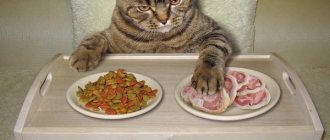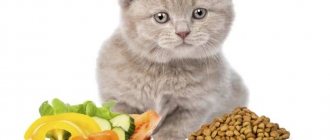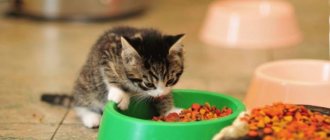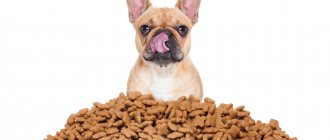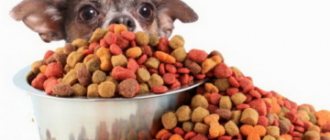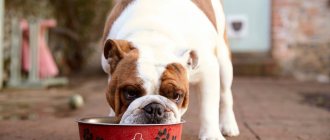Properly organized nutrition for a dog is an important factor that ensures not only the excellent condition of the body, but also the well-being of the animal. Thanks to dry food, it has become possible to properly feed your pet with balanced and healthy food, while saving money and time. But the difficulty lies in the fact that not every dog breeder knows how much food can be given, whether other products need to be added to the diet, and which ones. Having decided to feed his pet dry food, the owner must know how to do it correctly.
General rules for feeding dry food
Dry food is of great importance in a dog’s diet; it can be used as the main diet, but some rules must be taken into account:
- You should not feed an adult dog or puppy the cheapest product; there must be a balance between the price and quality of the food. The cheapest food will not benefit the animal’s body, but rather harm it;
- Dogs and puppies should be fed dry food only on a schedule; at the same time, the animal should receive the required amount of food. The owner decides how much food to give the animal independently based on the average norms and habits of the pet;
- By consuming dry food, the dog’s body needs a large amount of liquid. Therefore, a container with clean water at room temperature should always be in the puppy’s field of view.
- Dry food should only be stored in tightly closed containers at room temperature. Due to improper storage, it quickly deteriorates, and the owner may not notice this and continue to feed the animal with the spoiled product;
- You can accustom your pet to a new type of food over the course of 7-20 days, gradually increasing its portion.
It is necessary to feed dogs dry food correctly
Many owners transfer their own eating habits onto the dog and feed it the same way they feed themselves. This usually manifests itself in the fact that they consider dry food to be something like a “main course”, to which they must add something tasty, like dessert, in order to diversify the pet’s diet.
As we have already said, dry food is a complete product, balanced in all nutrients, which does not require any additional additives. If you regularly feed your dog natural food, canned food, or food from your table, then the balance is disrupted and a bias appears in the diet, most often towards an increase in fats or carbohydrates, which will naturally sooner or later affect the pet’s health.
At the same time, as a rule, it is customary to blame dry food for all troubles, and not those products that the owners, for some reason, consider more useful. Therefore, it is not only possible to feed your dog only dry food, but this is exactly what should be done. Of course, no one cancels treating your pet with treats, especially if these are products specifically intended for this purpose, purchased at a pet store, but they need to be included in the diet in a minimal amount. In general, they should make up no more than 10% of the total food intake per day.
Also, when feeding dry food, you should not forget about water, which should always be poured in a bowl and always remain clean. It is best to change it after each drink, because saliva and food debris from the dog’s mouth quickly contaminate the water and become a breeding ground for pathogenic bacteria.
By choosing the right dry food and following the rules of feeding it, you will provide your dog with adequate nutrition throughout its life and preserve your pet’s health for many years.
Is it healthy to feed your dog food only?
If you believe the advertising, then animals that eat only food get all the elements they need from food. But in reality this is not always correct . When choosing complementary food for your pet, you need to carefully read its composition, because there are very few foods that actually contain the entire complex of vitamins and minerals. It is worth clarifying that not all nutrients are absorbed in one go. Such a trifle can lead to disorders of the digestive system in puppies, so food should be especially carefully selected for them.
You need to choose the main food correctly in accordance with how old the individual is and what its weight is. In addition, you should remember that dry and natural food cannot be mixed. In this case, the use of food additives is prohibited, because this can cause hypervitaminosis in a puppy or dog. To increase the variety of your diet, you can supplement it with canned food of the same brand as dry food. It is also recommended to systematically use prebiotics.
Since the food in the dog’s stomach swells with water, it may experience constipation as a result of decreased motility of the gastrointestinal tract. Therefore, it is necessary to control the dog’s defecation process, especially the first time after introducing dry food into his diet. As a rule, after a certain period of time, the pet’s stomach gets used to dry food and its functionality is restored. If your animal suffers from constipation, you can give it special medications after consulting with your veterinarian.
Which dry food to choose?
Negative experiences with feeding dry food are usually associated with an incorrectly selected diet. You should understand that not all food is the same in composition, and know the basic physiological needs of dogs for nutrients, micro- and macroelements.
Dogs are carnivores, and therefore the basis of their diet should be meat products. None of the adaptations our pets acquired during the domestication process changed this fact. Only animal proteins and fats, and not their plant analogues, were and remain complete for dogs. From this point of view, you should evaluate puppy food if you want to raise a healthy, active and beautiful friend for many years.
When choosing dry food, you need to carefully study the list of its composition, and the first five ingredients should be of particular interest to you - these are precisely the components that are most abundant in the food. If it is fresh or dehydrated meat, then you can be sure that the dry food contains a sufficient amount of animal protein. In addition to meat and animal fat, puppies require other important nutrients, which you can learn more about in this article.
How to accustom a puppy to food
When a person buys a puppy, he needs to find out from the previous owners how he ate before and how much food he ate at one time. The first week after the puppy arrives at a new place, there is no need to change its diet.
After the animal adapts to the new environment, you can gradually give it dry food. If the baby likes the taste of food, then you should offer a little product soaked in water or special canned food. It is important to remember that puppies need to scratch their gums with hard objects. To do this, you can purchase special bones or dry tendons at the veterinary store. When introducing complementary foods into your puppy's diet, you need to carefully ensure that the animal does not develop redness on the skin, because this may be a sign of an allergy. This problem also has symptoms such as itching and excessive anxiety of the pet.
Having decided to feed your puppy dry food, you do not need to give him other nutritious foods, because mixed food is not recommended for dogs. Moreover, it is wrong to give small puppies any kind of food. It is important to ensure that your pet has enough water available to drink.
It is allowed to add vitamin and mineral supplements to the puppy’s diet in cases of illness, poisoning or infection. Also, along with the main food, you can give the puppy small treats in small quantities, such as:
- pieces of cheese;
- any boiled meat, with the exception of pork;
- crackers;
- dried fruits;
- special store-bought treats.
The puppy should receive such treats for following certain commands as a reward after eating.
The dry product can be fed to the puppy after he reaches three weeks of age, while he is still drinking his mother’s milk. Due to the fact that the animal does not have well-formed teeth, the food must be finely ground and warm water or milk added to it. At the age of 1.5 months, the puppy is already able to chew dry food.
It is also worth clarifying how many times a day puppies are fed:
- at the age of up to 2 months, the animal is fed 5-6 times a day, reducing this amount over time;
- at the age of 4-5 months, the puppy is fed no more than 3 times a day;
- after 6 months - no more than 2-3 feedings per day.
The best premium puppy foods
Every dog owner wants to see their pet healthy and active. To ensure good health in a puppy, just like in humans, one of the decisive factors is adequate nutrition. It is for this reason that the most widely used food in dog breeding is premium, as well as super premium food. They contain high-quality offal and rice, the share of natural meat reaches 25%, and the combination of microelements and vitamins is designed for each age group.
Purina Dog Chow
Purina Dog Chow Puppy is recommended for feeding puppies up to one year of age. The optimal combination of proteins and fats guarantees timely growth and harmonious development. In addition to the standard set of vitamins and microelements, Dog Chow contains natural prebiotics that serve for the normal functioning of the digestive system.
Pros:
- optimal energy value;
- a full range of vitamins and microelements;
- safety.
Minuses:
- the presence of preservatives and flavor enhancers;
- low meat content.
Purina Pro plan
The Pro Plan line of food will satisfy the most demanding owners of young dogs. Experienced veterinarians have developed special foods for puppies of different breeds, including those with sensitive digestive systems. The composition includes turkey, corn as a source of carbohydrates and fatty acids, and dry beet pulp as a source of fiber. Optistart food contains an analogue of canine colostrum, which promotes the formation of strong immunity in active and inquisitive puppies.
Pros:
- high meat content;
- mineral and vitamin complex;
- availability of canned meat in the line.
Minuses:
- the presence of unknown flavor enhancers and flavorings;
- significant content of corn flour, which is a strong allergen.
As a result of a large-scale study, it was found that the combination of dry and wet food in the diet of puppies is not only tasty, but also extremely healthy. Alternation makes it possible to fully satisfy the pet’s need for a variety of food, ensures optimal water-salt balance, and serves as a reliable prevention of urolithiasis and excess weight.
Royal Canin
Royal Canin Junior is designed specifically for feeding puppies aged 2 to 10 months. It allows you to fully satisfy the dog’s needs during the period of active growth, and contains prebiotics that help normalize intestinal activity. Sodium polyphosphate prevents the formation of tartar.
Pros:
- balanced composition;
- affordable price;
- safety for the pet's health.
Minuses:
- presence of preservatives;
- significant content of by-products;
- The percentage of meat is not specified.
Hills
The Science Plan Puppy diet, developed by Hills specialists, is suitable for puppies from the first month of life. The food has a high nutritional value, and a complex of antioxidants contributes to the formation of strong immunity. In addition to meat, the food contains corn and wheat - sources of carbohydrates and amino acids, and sugar beets, which provide the growing body with the necessary fiber.
Pros:
- optimal balance of vitamins and minerals, antioxidant complex;
- high nutritional value;
- prevalence and accessibility;
- small granules.
Minuses:
- possible occurrence of allergic reactions due to the presence of corn and wheat in the composition.
Advance
Advance produces a wide range of foods for puppies starting at three weeks of age. The main ingredients are rice cereal and chicken, the food is positioned as free of preservatives and artificial colors. Completely meets the puppy's need for phosphorus and calcium necessary for growth. Beneficial prebiotics promote smooth digestion.
Pros:
- balanced composition and easy digestibility;
- absence of dyes and preservatives;
- wide range.
Minuses:
- significant content of by-products;
- presence in corn.
Nature's Protection
The Nature's Protection line is represented by food for puppies of various breeds aged from 2 months to a year. High energy value satisfies 100% the young animal’s need for proteins and carbohydrates. The ingredients include poultry and fish meal, corn, brewer's yeast and powdered eggs. A balanced vitamin complex contains all the components necessary for the growth and development of a dog.
Pros:
- high nutritional value;
- optimal combination of minerals and vitamins.
Minuses:
- low meat content;
- presence of corn;
- high price.
How to accustom an adult dog to food
You can accustom an adult dog to food using the same methods as puppies, but you need to act more decisively.
Stages of accustoming an adult dog to food:
- Accustom the dog to food as a treat, sometimes rewarding them for following commands;
- Gradually mix dry food into regular food, increasing its amount over time;
- After the animal gets used to eating the food a little, you can start giving it for breakfast. If the dog refuses to eat, the same bowl must be given in the evening.
After 1.5 days the animal, as a rule, begins to eat food. If this does not happen, then you need to determine the reason.
Reasons for a dog’s lack of desire to eat food:
- In a hurry to accustom the dog to food, the owner missed one of the stages;
- The dog is not ready to start eating one food, you need to try again later;
- The animal did not like the taste of the food. In this case, you need to try giving her other brands of the product.
- The dog has an intolerance to some components of the food;
- An animal may refuse to eat due to some kind of malaise or poor health.
If it is necessary to switch the dog to another food, you need to do this gradually, just as when accustoming it to it.
How many times should you feed the dog after you manage to teach him to eat food and in what quantity? It depends on the weight and age of the animal. As a rule, an adult dog is fed 1-2 times a day. The norm is calculated for each individual individually according to the data on the product packaging.
